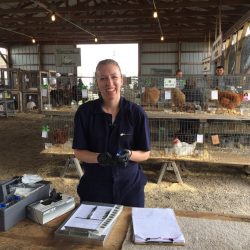By Dan Grooms, DVM, PhD, DACVM
Student PBAP Experience: Meagan Szarek
I was pretty nervous as Dr. Moore and I loaded into the truck one morning as I was going to perform my first solo field castration on a miniature donkey. I was on the third and final week of my Practice-Based Ambulatory Program (PBAP) rotation, and was going to be the "doctor" on the case. We spent the drive discussing how I was going to proceed, run field anesthesia, which drugs I was going to use, which instruments I needed and when, the pros and cons of standing castration versus laying the animal down, and every minute detail from initial physical exam to recovery. Dr. Moore made sure I had a plan and understood exactly how we were going to proceed. When we arrived, I was ready to introduce myself, perform a physical, and discuss the plan with the client.
One of the strengths of PBAP is the one-on-one interaction with a licensed DVM. For each case, you’re given the responsibility of knowing what to do next, from routine vaccines and dentals, to colic, enucleations, castrations, reproductive health, and the like. During our down time, driving from farm to farm, I had that practitioner’s undivided attention discussing cases, reviewing preventative medicine, vaccine protocols, common diseases, and even business management. The cases we saw were the type seen commonly in the field rather than the often more complicated referral cases seen at the MSU Veterinary Medical Center. For the majority of students that plan to enter private practice, the first opinion primary care caseload helps us to gain confidence for that day when we are the doctor climbing out of the truck for the first time!
The MSU College of Veterinary Medicine’s Practiced Based Ambulatory Program (PBAP) was created more than 20 years ago to provide a real-world, agriculture-based ambulatory experience to our students. It has been a critical part of our clinical training program, and is viewed by students, our stakeholders, and our educational accrediting body (the American Veterinary Medical Association’s (AVMA) Council on Education (COE)) as an outstanding educational program.
For those not familiar with PBAP, all MSU veterinary students spend three weeks with a large animal practice in Michigan. These practices may be all food animal, all equine, or a mix of both. Practices are located across the state from Manistique to Manchester and from Sandusky to Sparta. The goal is to provide a real-world ambulatory clinical experience where students develop their clinical skills and abilities to work with farm clients. Another unique aspect of PBAP is the connection it facilitates between the “mothership,” which is the MSU College of Veterinary Medicine, and private practices. These connections have been invaluable in a multitude of ways, including driving cases to the MSU Veterinary Medical Center, serving as a conduit to support field research, and connecting our students with job opportunities. The network that PBAP has created cannot be overstated.
Ultimately, the success of this program lies with our valued practice partners. Busy practices from all over the state have taken our students under their wings during this three-week clinical clerkship, and help shape them into competent veterinarians. The practitioners have assessed the students' skill sets and patiently coached them to the next level while keeping them safe from injury. In the past 20 years, close to 2,500 students have spent roughly 7,500 weeks—or 37,500 days—gaining invaluable veterinary and life experiences from our practice partners. Simply put, these practices and the veterinarians in them rock!
Over the years, PBAP has evolved as our profession changes. Practices have come and gone. Objectives and assignments have changed. Demographics of the students going to PBAP practices have evolved. One of the changes we in academia are facing is accreditation standards. To be an accredited veterinary school in North America, colleges of veterinary medicine must meet certain standards that are established by the AVMA COE. These standards evolve over time, and usually become more rigorous. This is a good thing for our profession, and it forces colleges to make changes to meet these standards.
Recent COE changes have focused on core (required) parts of the veterinary education that occur outside college facilities, such as the practices that are part of our PBAP. These are often referred to as distributed-core educational sites. If implemented, these changes would result in significant costs to the College and, ultimately, students. More importantly, it could result in significant costs and outside scrutiny in the form of audits for our practice partners. Because of this, the College has made the decision to change the PBAP clerkship from a required clerkship to a highly recommended clerkship. By doing this, the COE standards for distributed-core educational sites do not apply.
Moving forward, we continue to view PBAP as an outstanding and important clinical training experience, and will take steps to encourage all students to take this clerkship during their clinical training program. This will require us to market the importance of the program to students, regardless of their intended career pathway. In fact, after preliminary clinical clerkship scheduling for the Class of 2019, with the PBAP clerkship being listed as an elective, a large proportion of the class has indicated they wish to take the clerkship. From my view, the changes being made will allow us to make this program better, both for students and our practice partners.
Many of you have heard me talk about challenges and opportunities. Here is a great example of this. A challenge has been thrown our way. As a team, we will find an opportunity that is a win-win for everyone. Spartans Will!



